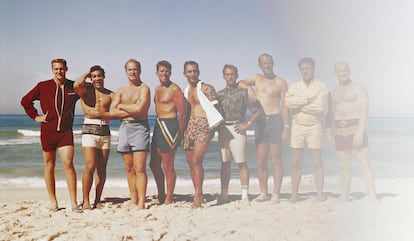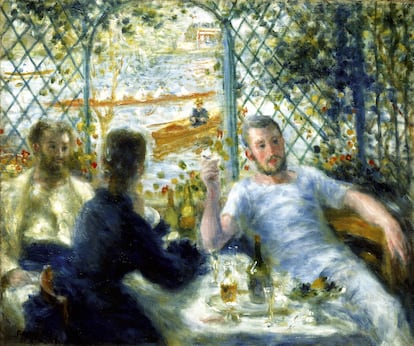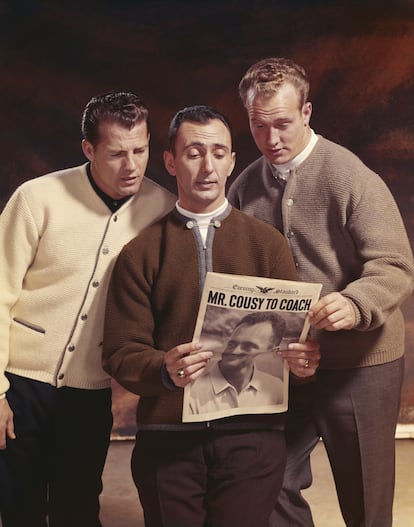Why men have fewer and fewer friends
Specialists warn that we are witnessing a worrying decline in friendships, both as an institution and as a concept, which could be influenced by the rise of social media and our lack of time


Take good note, because (almost) everything that is trending in the United States quickly spreads to the rest of the world. American press, such as CNN and Vox, has begun to map a strange phenomenon, provisionally baptized as “the friendship recession.” The number of “informal but intense” relationships of affection and sympathy among men, especially younger men, is steadily declining. According to data from Gallup and the Survey Center on American Life, the percentage of male citizens who claim to have at least six close friends has been cut in half between 1990 and 2022. This declining friendship syndrome has been exacerbated by the change in habits and lifestyles brought about by the pandemic, with more than 20% of Americans reporting that they have no close friends at all.
If we were to take this data at face value, says psychologist and family physician Sebastian Tong, “we would be witnessing a worrying decline in friendship as an institution and as a concept.” The supply chain of soulmates willing to “walk beside us” from one twilight to the next, as Albert Camus would say, is being interrupted. And this is something we cannot blame it on an untimely traffic jam in the Suez Canal, as in the case of microchips. If the cult of friendship languishes, it will be for lack of good parishioners.
However, Tong points out a nuance: “Perhaps what is really changing is our cultural notion of intimate friendship.” In other words, “it is very likely that, in a world of multiple, epidermal and meaningless relationships through channels such as social media, what is happening is that we have raised the standard of what we understand as genuine friendship and many of our social relationships have ceased to live up to this new demand.” That is to say, “the contrast between everyday reality and our expectations is perhaps causing us to idealize friendship to the point of demanding more from it than it can reasonably give us.”
The unstoppable emergence of the friendless man
Why is this happening more to men than to women? According to Tong, “perhaps simply because men are more likely to verbalize feelings of dissatisfaction in surveys.” Or, in the words of California psychologist Ron Riggio, men have a “more instrumental” sense of friendship. They seek “occasional accomplices” with whom to share small routines rather than “confidants” or a social support network, something that women tend to do.

Journalist and illustrator Aubrey Hirsch, one of the driving forces behind the male friendship recession theory, attributes the phenomenon to the fact that “we tend to socialize young boys in particular to hide their vulnerabilities and value toughness and stoicism over emotional sensitivity and connection.” This mental framework is not the most suitable, in her opinion, for creating “lasting connections.” “Maybe it’s time to rethink what it means to be a good man, for their sake and for society’s.”
The diagnosis, in short, is complex. Tong believes that there are multiple variables at play, and that perhaps it would be very useful to first ask the 20% of American men who feel friendless what they mean by “friendlessness.” Are we talking about true loneliness, an inability to establish solid social connections, or just “high aspirations disappointed by experience”?
As Jean-Luc Henning explains in De l’extrême amitié [On extreme friendship], if by friendship we mean that “peculiar form of love,” that visceral and almost exclusive attachment “between different but equal” that united Michel de Montaigne and Étienne de la Boétie, it would be strange to find such a friend in life, let alone more than one. Emily Boynton, editor of the digital health newsletter “Right as Rain,” points out that the decline of friendship could also be due to the most pedestrian of causes: “Friends demand time we no longer have.”
Friendship as the enemy of the clock (and the calendar)
Sanya Nayeem, also a journalist, goes one step further and quantifies this time. Based on a study by Medium magazine, Nayeem states, with commendable conviction, that “friendship responds to the formula 11-3-6.″ That is, you need a minimum of 11 meetings of at least three hours in a period of six months to “turn an acquaintance into a true friend.”

Don’t overlook the phrase “to turn into.” Friendship, conceived in these terms, would thus be an industrial production process whose ingredients would be affinity plus willingness plus time. Nayeem concludes that completing the cycle of friendship production has become much more complicated after the pandemic, given that, according to data from the Pew Research Center, 35% of Americans admit that they now devote “less time and energy” to face-to-face social and leisure activities. A word to the wise: “non-face-to-face” friendships very rarely reach the status of “intimate or true friendships.”
These attempts to reduce friendship to a formula or a “technique” are reminiscent of the famous 10,000-hour rule, the time it would take to achieve excellence in any human activity. As the journalist and sociologist Malcolm Gladwell once said, it would be the time the Beatles invested between 1959 and 1962 to become the best popular music band on the planet. Compared to that Herculean effort, reaching that optimum figure of “at least six close friends” would require a very modest investment: barely 200 hours. The problem, in Nayeem’s opinion, is that friendships are “relatively easy to obtain,” but then you have to “invest a lot of time and effort” in keeping them.
Joseph Juran, the late quality management expert, suggested that a good strategy to avoid recklessly squandering the social capital accumulated through time, effort and dedication would be to apply the Pareto principle to friendship. According to the Italian mathematician Vilfredo Pareto, in most processes, 20% of the causes produce 80% of the results. Translated to friendship, according to Juran, it is the 20% of your friends that will end up producing 80% of the enriching and satisfying social interactions. So, if you don’t have time to consciously cultivate your relationship with all of them, identify those one in five who make a difference and focus on them. The rest could be neglected or discarded without remorse. They simply do not contribute significant returns to the friendship economy.
Friendship and virtuality
The subject allows, of course, much less prosaic approaches. For writer Use Lahoz, author of novels such as Los buenos amigos [The good friends], in which friendship “is one of the central themes,” few phrases sum up this feeling as precisely as this one, attributed to Argentine singer-songwriter Atahualpa Yupanqui: “A friend is oneself with another skin.”

Lahoz is reluctant to believe that there is a generalized decline in affection and genuine connection between human beings: “Rather, I believe that friendships are so valuable to us that it hurts us to lose them or to see them fade away.” They are a scarce commodity, and it is their very scarcity that generates a feeling of “lacking.” The writer adds that “friendship is transformed with life, and that leads us to melancholic conclusions such as what Jules Renard said: ‘There are no friends, there are moments of friendship.’”
Based on his own experience, Lahoz affirms that “sustaining feelings over time is a very demanding challenge, and that explains why many friendships are left behind as soon as you enter middle age, the time when you finally understand that, as Gil de Biedma said, life is serious, that is, that it is much more ephemeral than it seemed.” Missing those intimate connections based on “affinity, complicity and purity of intentions” and feeling a certain mourning for their loss is part of the vital process. Lahoz even makes a lance in favor of the much-maligned nostalgia: “It can be a refuge from which to draw reserves and in which to recharge energy to face adulthood. For me, the past is less a hindrance than a treasure.” The novelist concludes with a final quote, this time from Eugénio de Andrade, which sums up the richness and ambivalence of that ambiguous passion we call friendship: “A friend is sometimes the desert, sometimes water.”
Hèctor Zacarias, journalist and philologist, has a theory: perhaps we are in a period of transition to a different model of friendship, not necessarily better, and the decline we perceive is due to the fact that we have not yet finished processing the changes. He believes that the “multiple channels created to create a feeling of artificial proximity with the people we love are nothing more than a simulacrum.” You have to see your friends, touch them, do things with them, listen to them in the real world.
Unfortunately, this corporeal and “tactile” character of friendship, as we have come to understand it, is not very compatible with the lifestyles to which we have become accustomed and means that we end up settling for the other, for the substitute: “Until the day comes when a pollster asks you point-blank how many friends you have and you, in an act of cold introspection, end up recognizing that very few — only those who have not been falling by the wayside and have managed to cross, among other obstacles, the desert of virtuality.”
Sign up for our weekly newsletter to get more English-language news coverage from EL PAÍS USA Edition
Tu suscripción se está usando en otro dispositivo
¿Quieres añadir otro usuario a tu suscripción?
Si continúas leyendo en este dispositivo, no se podrá leer en el otro.
FlechaTu suscripción se está usando en otro dispositivo y solo puedes acceder a EL PAÍS desde un dispositivo a la vez.
Si quieres compartir tu cuenta, cambia tu suscripción a la modalidad Premium, así podrás añadir otro usuario. Cada uno accederá con su propia cuenta de email, lo que os permitirá personalizar vuestra experiencia en EL PAÍS.
¿Tienes una suscripción de empresa? Accede aquí para contratar más cuentas.
En el caso de no saber quién está usando tu cuenta, te recomendamos cambiar tu contraseña aquí.
Si decides continuar compartiendo tu cuenta, este mensaje se mostrará en tu dispositivo y en el de la otra persona que está usando tu cuenta de forma indefinida, afectando a tu experiencia de lectura. Puedes consultar aquí los términos y condiciones de la suscripción digital.
More information
Últimas noticias
Most viewed
- Reinhard Genzel, Nobel laureate in physics: ‘One-minute videos will never give you the truth’
- Oona Chaplin: ‘I told James Cameron that I was living in a treehouse and starting a permaculture project with a friend’
- Pablo Escobar’s hippos: A serious environmental problem, 40 years on
- Why we lost the habit of sleeping in two segments and how that changed our sense of time
- Chevy Chase, the beloved comedian who was a monster off camera: ‘Not everyone hated him, just the people who’ve worked with him’










































